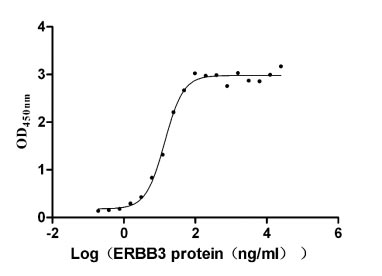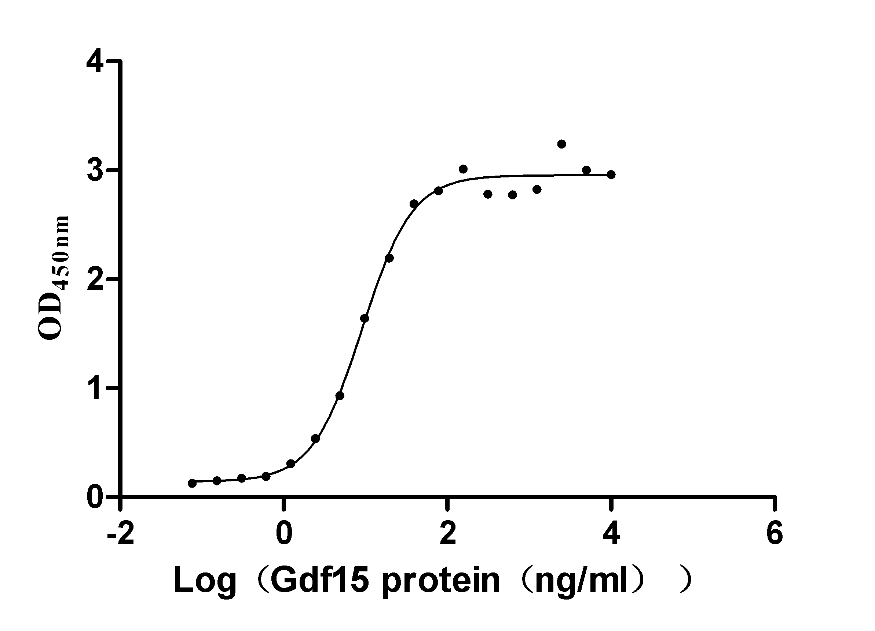Recombinant Rat Aquaporin-5 (Aqp5)
-
中文名称:Recombinant Rat Aquaporin-5(Aqp5)
-
货号:CSB-CF001965RA
-
规格:
-
来源:in vitro E.coli expression system
-
其他:
产品详情
-
基因名:Aqp5
-
Uniprot No.:
-
别名:Aqp5; Aquaporin-5; AQP-5
-
种属:Rattus norvegicus (Rat)
-
蛋白长度:Full length protein
-
表达区域:1-265
-
氨基酸序列MKKEVCSLAFFKAVFAEFLATLIFVFFGLGSALKWPSALPTILQISIAFGLAIGTLAQALGPVSGGHINPAITLALLIGNQISLLRAVFYVAAQLVGAIAGAGILYWLAPLNARGNLAVNALNNNTTPGKAMVVELILTFQLALCIFSSTDSRRTSPVGSPALSIGLSVTLGHLVGIYFTGCSMNPARSFGPAVVMNRFSPSHWVFWVGPIVGAMLAAILYFYLLFPSSLSLHDRVAVVKGTYEPEEDWEDHREERKKTIELTAH
Note: The complete sequence including tag sequence, target protein sequence and linker sequence could be provided upon request. -
蛋白标签:N-terminal 10xHis-tagged
-
产品提供形式:Liquid or Lyophilized powder
Note: We will preferentially ship the format that we have in stock, however, if you have any special requirement for the format, please remark your requirement when placing the order, we will prepare according to your demand. -
缓冲液:Lyophilized from Tris/PBS-based buffer, 6% Trehalose, pH 8.0
-
储存条件:Store at -20°C/-80°C upon receipt, aliquoting is necessary for mutiple use. Avoid repeated freeze-thaw cycles.
-
保质期:The shelf life is related to many factors, storage state, buffer ingredients, storage temperature and the stability of the protein itself.
Generally, the shelf life of liquid form is 6 months at -20°C/-80°C. The shelf life of lyophilized form is 12 months at -20°C/-80°C. -
货期:Basically, we can dispatch the products out in 1-3 working days after receiving your orders. Delivery time may differ from different purchasing way or location, please kindly consult your local distributors for specific delivery time.Note: All of our proteins are default shipped with normal blue ice packs, if you request to ship with dry ice, please communicate with us in advance and extra fees will be charged.
-
注意事项:Repeated freezing and thawing is not recommended. Store working aliquots at 4°C for up to one week.
-
Datasheet & COA:Please contact us to get it.
相关产品
靶点详情
-
功能:Forms a water-specific channel. Plays an important role in fluid secretion in salivary glands. Required for TRPV4 activation by hypotonicity. Together with TRPV4, controls regulatory volume decrease in salivary epithelial cells. Seems to play a redundant role in water transport in the eye, lung and in sweat glands.
-
基因功能参考文献:
- These findings support the involvement of AQP5 in oxidative stress and suggest AQP5 modulation by phosphorylation as a novel tool for therapeutics. PMID: 27983600
- hypothyroid state induced significant increases in the expression of lung phospho-MLC and AQP5 proteins. In contrast, the hyperthyroid state caused moderate decreases in lung phospho-MLC and AQP5 proteins PMID: 25649359
- AQP5 translocates to the nuclear membrane and may trigger the movement of water, inducing shrinkage of the nucleus and the start of nuclear functions. PMID: 25603543
- These results lead us to propose that oxytocin selectively influences the expression of Aqp5 at the end of pregnancy, and may participate in events that lead to parturition in the rat. PMID: 24644013
- After ovulation AQP5 is involved in the transcellular movement of water in the oviduct ampulla and oocytes in rats. PMID: 24192214
- the present study has shown that AQP5 participates in the development of lung edema induced by bacterial endotoxin. PMID: 23538169
- The results of this study indicated that AQP5 might be an important water channel in astrocytes that is differentially expressed during various brain injuries. PMID: 23922257
- AQP5 is a significant component of lens fiber cell membranes, representing the second most abundant water channel in these cells. PMID: 23313152
- AQP5 is the main pathway for water transport in the acinar cells. PMID: 22903161
- AQP5 expression in the apical membrane of acinar cells was less prominent in the experimental rats. Findings suggest that unilateral molar extraction influences the function of water transport in the rat submandibular salivary gland. PMID: 22424887
- Aquaporin-5 was present at the apical face of the olfactory epithelium, completing a water transport pathway to the surface of the epithelium. PMID: 21745799
- AQP5 immunolabeling of the RPE was increased in retinal slices from diabetic rats in comparison to slices from control rats. PMID: 21851171
- AQP5 production is regulated through the cAMP-PKA/CREB pathway in rat nasal epithelial cells. PMID: 21991573
- Glucocorticoid can down-regulate the expression of AQP5, but H1-receptor antagonist can not reduce the expression of AQP5 in in nasal mucosa of rats with experimental allergic rhinitis. PMID: 20128285
- Data suggest that Lack of AQP5 translocation in the salivary gland in response to a muscarinic agonist and downregulation of AQP5 protein might lead to diabetic xerostomia. PMID: 21295117
- Replacement of Gly103 with Asp103 in rat AQP5 did not affect water permeability. PMID: 21138418
- The hypersecretion of nasal mucosa glands has a close relationship with the high expression of AQP5 in allergic rhinitis. PMID: 15952563
- The significant decrease in AQP5 may be an important factor of pulmonary edema formation in hyperoxia-induced lung injury. PMID: 16887054
- We conclude that the presence of AQP5 in plasma membranes of sweat glands is essential for secretion, providing potential insight into mechanisms underlying mammalian thermoregulation, tactile sensitivity, and the pathophysiology of hyperhidrosis PMID: 11773623
- Genetic variation in the expression of AQP5 in rats. PMID: 12466944
- AQP-5 is localized predominantly in apical plasma membrane, and neither onset nor cessation of secretion is associated in vivo with any significant short-term translocation of AQP-5 between intracellular structures and the apical plasma membrane. PMID: 14988067
- This review focuses on mechanisms of AQP5 translocation in the interlobular duct cells of parotid glands of normal, diabetic, and senescent rats following activation of M3 muscarinic acetylcholine receptors. PMID: 15548853
- AQP5 localizes in lipid rafts and activation of the M3 mAChRs or alpha1-adrenoceptors induced its translocation together with the lipid rafts to the APM in the interlobular ducts of rat parotid glands. PMID: 16712780
- This mutation may have resulted in an abnormal membrane insertion or ineffective trafficking of AQP5. PMID: 16901987
- In conditions that increased AQP5 levels, cells showed a faster cell swelling and a more complete volume recovery following hyposmotic exposure PMID: 17021794
- Hypertonic induction of both AQP5 and VEGF is transcriptionally regulated and mediated, at least in part, by HIF-1alpha, suggesting a novel role for HIF-1alpha in modulating cellular adaptive responses to osmotic stress. PMID: 17108010
- AQP5 protein is necessary for sweat secretion, and that the expression of AQP5 in rat sweat glands is independent of sympathetic innervation PMID: 17380350
- 4.3-kb Aqp5 promoter/enhancer directs strong cell-specific transgene expression in salivary gland and low-level AT1 cell-specific expression in the lung. PMID: 18448628
- These results suggest the possible regulation of the AQP5 protein level in the submandibular gland by the parasympathetic nerves/M3 muscarinic receptor agonist and imply the involvement of lysosomal enzymes in this regulation. PMID: 18450949
- GATA-6 mediates transcriptional activation of aquaporin-5 through interactions with Sp1. PMID: 18768929
- the suppression of PACE4 expression by siRNAs resulted in decreased expression of AQP5 and inhibition of the branching morphogenesis in the present organ culture system. PMID: 19013448
- gas channels exhibit selectivity for CO(2) vs. NH(3) permeability, demonstrating the sequence AQP4 congruent with AQP5 > AQP1 > AmtB > RhAG. PMID: 19273840
- A disturbance of AQP5 translocation may be involved in the pathogenesis of X-ray irradiation-induced xerostomia. PMID: 19673936
显示更多
收起更多
-
亚细胞定位:Apical cell membrane; Multi-pass membrane protein. Cell membrane; Multi-pass membrane protein. Cytoplasmic vesicle membrane; Multi-pass membrane protein.
-
蛋白家族:MIP/aquaporin (TC 1.A.8) family
-
组织特异性:Salivary glands, lacrimal glands, corneal epithelium in eye, trachea and lung.
-
数据库链接:
KEGG: rno:25241
STRING: 10116.ENSRNOP00000024102
UniGene: Rn.10066
Most popular with customers
-
Recombinant Human Receptor tyrosine-protein kinase erbB-3 (ERBB3), partial (Active)
Express system: Mammalian cell
Species: Homo sapiens (Human)
-
Recombinant Mouse GDNF family receptor alpha-like (Gfral), partial (Active)
Express system: Mammalian cell
Species: Mus musculus (Mouse)
-
Recombinant Human IL12B&IL12A Heterodimer Protein (Active)
Express system: Mammalian cell
Species: Homo sapiens (Human)
-
Recombinant Human C-type lectin domain family 4 member C (CLEC4C), partial (Active)
Express system: Mammalian cell
Species: Homo sapiens (Human)
-
Recombinant Human Interleukin-2 receptor subunit alpha (IL2RA), partial (Active)
Express system: Mammalian cell
Species: Homo sapiens (Human)
-
Recombinant Mouse CUB domain-containing protein 1 (Cdcp1), partial (Active)
Express system: Mammalian cell
Species: Mus musculus (Mouse)
-
Recombinant Macaca fascicularis Gastric inhibitory polypeptide receptor (GIPR), partial (Active)
Express system: yeast
Species: Macaca fascicularis (Crab-eating macaque) (Cynomolgus monkey)
-
Recombinant Human Interleukin-1 receptor accessory protein (IL1RAP), partial (Active)
Express system: Mammalian cell
Species: Homo sapiens (Human)




















